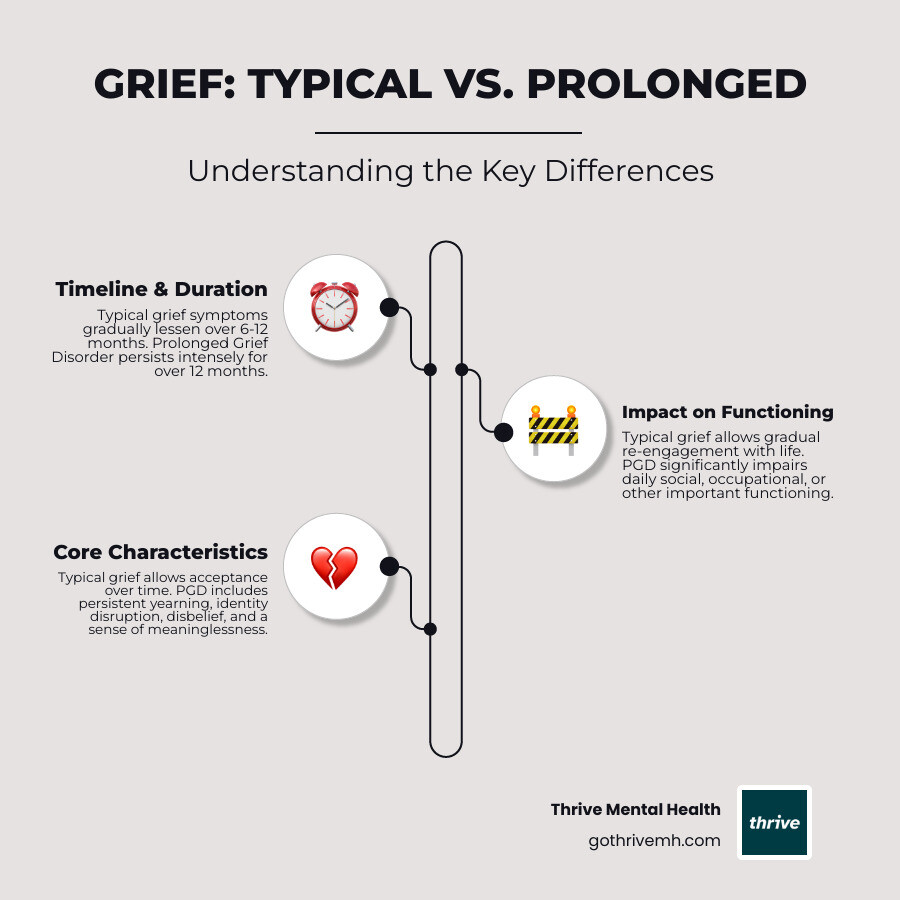EMDR for Grief—When Memories Hurt, Let Your Eyes Do the Talking

When Grief Gets Stuck: How EMDR Can Help You Heal
EMDR therapy for grief is a specialized treatment that helps people process traumatic aspects of loss through guided eye movements and bilateral brain stimulation. Here’s what you need to know:
Key Benefits of EMDR for Grief:
- Reduces emotional intensity of painful memories
- Processes trauma without repeatedly retelling the story
- Transforms overwhelming grief into manageable sadness
- Preserves positive memories while healing pain
- Typically shows results in 8-12 sessions
Best For:
- Sudden or traumatic losses
- Grief lasting over 6-12 months
- Avoidance of reminders of your loved one
- Feeling stuck in intense yearning or disbelief
Loss touches every life. Whether it’s the death of a parent, spouse, child, or close friend, grief can feel like a meteor of emotions crashing into your world. For most people, the sharp edges of grief soften over time. But sometimes grief gets stuck.
When memories of loss trigger flashbacks, when you can’t bear to visit places that remind you of someone, or when grief feels as raw today as it did months ago – that’s when complicated grief takes hold. The natural healing process gets blocked, leaving you trapped in a cycle of pain.
EMDR therapy for grief offers a different path forward. Instead of talking through your loss repeatedly, this approach uses bilateral stimulation to help your brain reprocess traumatic memories. It’s like giving your mind permission to heal while keeping the love intact.
As CEO of Thrive Mental Health, I’ve seen how EMDR therapy for grief transforms lives for people across Florida by helping them move from surviving their loss to finding meaning again. Our work with individuals and families throughout the state has shown me that the right therapeutic approach can open up healing when traditional methods fall short.

Emdr therapy for grief vocab to learn:
Understanding the Landscape of Loss: When Grief Becomes Complicated
Grief is one of those experiences that connects us all as humans. Whether we’ve lost a parent, spouse, child, or dear friend, that deep ache in our chest feels both uniquely personal and universally understood. Most of the time, grief follows a natural path – intense at first, then gradually softening as we learn to carry our love in new ways.
But sometimes, grief doesn’t follow the expected journey. Sometimes it gets stuck.
The Many Faces of Grief
Grief shows up differently for everyone, and it can surprise us with how it affects our entire being – emotionally, mentally, and physically.
Emotionally, you might find yourself cycling through feelings that seem to come out of nowhere. Deep sadness can hit like a wave, leaving you breathless. Anger might bubble up – at the person who died, at yourself, at the unfairness of it all. Guilt often whispers cruel things about what you should have said or done differently.
Sometimes you might feel completely numb, like you’re watching your life through glass. This emotional shutdown isn’t weakness – it’s your mind’s way of protecting you from overwhelming pain.
Cognitively, grief can make you feel like you’re living in a fog. Brain fog is real – you might walk into a room and forget why you came, or struggle to focus on conversations. Your mind might get stuck replaying the same memories or “what if” scenarios over and over.
Physically, grief shows up in ways that can catch you off guard. Fatigue that sleep doesn’t fix. Changes in appetite – either losing interest in food completely or finding yourself eating without really tasting anything. Your body might ache in places that have nothing to do with physical injury, or you might find yourself getting sick more often as grief taxes your immune system.
Social withdrawal often happens naturally. The world keeps spinning while yours has stopped, and it can feel impossible to engage with everyday conversations about weekend plans when you’re struggling just to get through each day.
When Grief Lingers: Identifying Prolonged Grief Disorder (PGD)

For most people, the sharp edges of grief gradually soften over time. But for about 7-10% of people who experience loss, grief becomes complicated. What mental health professionals now call Prolonged Grief Disorder happens when the natural healing process gets blocked.
PGD isn’t just “taking longer to grieve.” It’s when grief symptoms remain as intense and disruptive as they were in those first raw weeks, but symptoms lasting over a year without significant improvement. The pain doesn’t just linger – it dominates your life.
Key signs that grief has become complicated include intense yearning that feels as fresh as day one. You might experience identity disruption – feeling like part of you died with your loved one. Disbelief about the death can persist long after the funeral, making the loss feel surreal and impossible to accept.
Avoidance of reminders becomes a way of life. You might take different routes to avoid places you went together, or find yourself unable to look at photos or listen to songs that bring back memories. On the flip side, some people become completely preoccupied with reminders, unable to focus on anything else.
Perhaps most heartbreaking is when life feels meaningless without your loved one. The future looks empty, and it becomes impossible to imagine finding joy or purpose again.
Certain factors increase the risk for complicated grief. Sudden loss or traumatic circumstances around the death can make it harder for your brain to process what happened. Lack of social support during the grieving process can leave you feeling isolated and stuck.
This is where EMDR therapy for grief, available through our specialized programs in Florida, can make a real difference. Unlike traditional talk therapy that focuses on discussing your feelings, EMDR helps your brain reprocess the traumatic aspects of your loss so healing can begin naturally. You can learn more about What is Prolonged Grief Disorder? from mental health professionals who understand this complex condition.
The good news? Even complicated grief can heal with the right support and treatment approach.
How EMDR Therapy for Grief Works: Reprocessing Painful Memories
When someone you love dies, your brain works overtime trying to make sense of the loss. Usually, our minds are pretty good at processing difficult experiences. But sometimes – especially with sudden deaths or traumatic circumstances – the brain’s natural filing system gets jammed.
This is where EMDR therapy for grief becomes so valuable. Instead of leaving you stuck with raw, overwhelming memories, EMDR helps your brain complete the processing it couldn’t finish on its own. The goal isn’t to erase your love or forget your person. It’s about changing the trauma of loss so you can access your loving memories without being overwhelmed by pain.
The Science Behind EMDR Therapy for Grief: AIP and Dual Process Models
EMDR therapy is built on something called the Adaptive Information Processing (AIP) model. Think of your brain like a library with an amazing filing system. When something traumatic happens – like losing someone you love – that experience can get stuck in the “urgent” pile instead of being properly filed away.
These maladaptively stored memories stay raw and unprocessed. Every time something reminds you of your loss, it’s like opening that urgent pile and having all the emotions, sounds, and sensations flood back as if the loss just happened. Your brain treats a memory from months ago like it’s happening right now.
EMDR therapy for grief uses bilateral stimulation – usually guided eye movements – to help your brain’s natural processing system get unstuck. It’s like giving your mental librarian the tools they need to properly file away the traumatic aspects of your loss.
The Dual Process Model adds another helpful layer to understanding grief. This research shows that healthy grieving involves moving back and forth between two types of coping: loss-oriented stressors (feeling the sadness, missing your person) and restoration-oriented stressors (learning new roles, building a life without them).
When grief gets complicated, people often get stuck in one mode or the other. EMDR therapy for grief helps by processing the traumatic memories that keep you trapped in loss-oriented thinking, while also building your capacity to engage with restoration-oriented tasks. You can learn more about the latest Research on EMDR for prolonged grief in recent studies.
The 8-Phase Journey: What to Expect from EMDR Therapy for Grief Sessions
EMDR therapy for grief follows a careful, step-by-step process designed to keep you safe while helping you heal. Here’s what you can expect as we work together:
History-taking and preparation come first. We’ll spend time understanding your unique loss and how it’s affected your life. This isn’t about rushing into the painful stuff – it’s about building a strong foundation for the work ahead. Every grief story is different, and we need to understand yours.
During the preparation phase, you’ll learn coping tools to help you feel grounded and safe. Think of these as your emotional first aid kit. We might practice breathing techniques or safe place visualizations. You won’t move forward until you feel ready and equipped.
Assessment is where we identify the specific memories or images that hold the most pain for you. Maybe it’s the phone call with the news, or the last conversation you had, or walking into their empty room. We’ll also identify the negative beliefs these memories have created about yourself or your future.
The desensitization phase is where the real EMDR magic happens. While you focus on the painful memory, you’ll follow my finger with your eyes as I guide them back and forth. This bilateral stimulation helps your brain reprocess the stuck memory. You might feel different emotions or have new thoughts come up – that’s your brain doing its natural healing work.
During installation, we strengthen positive beliefs to replace the negative ones. If trauma made you believe “I should have saved them,” we work to install something like “I loved them deeply and that love continues.”
The body scan helps us make sure your body has released the physical tension that often comes with traumatic memories. Closure ensures you leave each session feeling stable and grounded. Finally, re-evaluation at the start of each new session helps us track your progress and plan our next steps.
This process typically takes 8-12 sessions, though everyone’s timeline is different. The goal is helping you move from being haunted by traumatic memories to being able to honor your loved one with less overwhelming pain.
The Unique Benefits of Choosing EMDR for Grieving
When you’re struggling with grief, you want healing that actually works. While traditional talk therapy offers valuable support, EMDR therapy for grief brings something different to the table – especially when your loss feels traumatic or you’ve been stuck in pain for months.
The differences are striking. In traditional therapy, you’ll spend sessions talking through your feelings and exploring your thoughts about the loss. With EMDR therapy for grief, you focus directly on the distressing memories themselves, using bilateral stimulation like eye movements to help your brain reprocess them. Instead of repeatedly telling your story, you’re actually changing how your brain stores these painful experiences.
| Aspect | EMDR Therapy for Grief | Traditional Talk Therapy (e.g., CBT, general counseling) |
|---|---|---|
| Session Focus | Direct processing of distressing memories, sensations, and negative beliefs related to the loss. Aims to reprocess the trauma of loss. | Verbal exploration of feelings, thoughts, and experiences related to grief. Focuses on coping strategies, understanding emotions, and narrative building. |
| Processing Method | Uses bilateral stimulation (eye movements, tapping, tones) to facilitate the brain’s natural processing. Less reliance on verbal recounting. | Primarily relies on verbal dialogue, cognitive restructuring, and behavioral exercises. May involve repeated discussion of the loss. |
| Handling Traumatic Memories | Helps individuals distance themselves emotionally from distressing memories without repeated detailed recounting, reducing the risk of re-traumatization. | May involve exposure to traumatic memories through detailed verbal recounting, which can be challenging for some individuals. |
| Duration of Treatment | Often shows significant improvements in fewer sessions, with some studies showing faster symptom reduction (e.g., 8 sessions). | Can be a longer-term process, with progress often depending on the depth of verbal exploration and client engagement with homework. |
| Outcome for Memories | Reduces the emotional intensity of disturbing memories, allowing for adaptive integration and increased access to positive memories of the deceased. | Helps manage and understand grief, but may not directly alter the emotional charge of specific traumatic memories in the same physiological way. |
| Relationship with Deceased | Transforms the connection from “loving in presence” to “loving in absence” by fostering heartfelt memories and reducing pain associated with the loss. | Supports acceptance and adaptation, helping to integrate the loss into one’s life, but may not have the same direct impact on the quality of memory recall. |
What makes EMDR particularly powerful is its accelerated healing timeline. Many people see meaningful changes in around 8 sessions, compared to months or years with other approaches. You’re not just learning to cope with overwhelming emotions – you’re actually reducing their intensity at the source.
Perhaps most importantly, EMDR helps you develop improved coping skills while changing your relationship with the deceased. Instead of avoiding memories because they hurt too much, you learn to honor their memory in a way that brings comfort rather than pain.
From Painful Intrusions to Cherished Memories
Here’s where EMDR therapy for grief gets really beautiful. Many people come to therapy because thinking about their loved one brings overwhelming pain. Maybe you can’t look at photos without falling apart. Maybe you avoid their favorite restaurant because the memories are too intense.
EMDR works by processing the traumatic aspects of the loss while preserving what matters most – your love for that person. After treatment, people often describe a profound shift. The memories that once felt like emotional attacks become gentler. The sadness is still there, but it’s not the crushing weight it used to be.
One of the most remarkable findings in research is that EMDR participants report increased access to positive memories of their loved ones. This doesn’t happen with other treatments. Instead of being haunted by how they died, you start remembering how they lived. Their laugh. Their terrible jokes. The way they made you feel safe.
This change allows for what therapists call “loving in absence” – maintaining a healthy continuing bond with someone who’s gone. A Study on EMDR’s effectiveness shows how this shift from traumatic intrusion to cherished memory can happen relatively quickly with the right treatment.
The process also helps you handle secondary losses – like losing mutual friends or having to change jobs after your loss. EMDR can even work on future scenarios, helping reduce anxiety about upcoming anniversaries or events you’ll face without your loved one.
Integrating EMDR with Other Grief Support
EMDR therapy for grief doesn’t have to be a solo journey. In fact, it often works best when combined with other types of support, creating a complete healing environment.

Complementing talk therapy creates a powerful combination. While EMDR reprocesses the emotional charge of traumatic memories, traditional therapy gives you space to make sense of your experience through words. You get the physiological healing of EMDR plus the insight and understanding that comes from exploring your story with a skilled therapist.
Enhancing mindfulness practices is another natural fit. The grounding techniques you learn during EMDR preparation – like mindful breathing and body awareness – become tools you can use anytime grief feels overwhelming. This mind-body connection often gets disrupted by trauma and loss, and combining EMDR with mindfulness helps restore that balance.
At Thrive Mental Health, we understand that grief affects every part of your life. That’s why our programs in Florida offer comprehensive, expert-led care that can integrate EMDR with group therapy, family sessions, and practical skill-building. Our intensive outpatient and partial hospitalization programs create a holistic support system that addresses not just your grief, but how to rebuild your life around it.
This integrated approach helps you develop resilience for the future. You’re not just processing what happened – you’re building the strength and skills to handle whatever comes next. Whether you’re dealing with the first anniversary of your loss or learning to steer holidays without your person, having multiple tools in your toolkit makes all the difference.
The goal isn’t to “get over” your grief – it’s to transform your relationship with it so you can carry your love forward while still engaging fully with life.
Frequently Asked Questions about EMDR for Grief
If you’re considering EMDR therapy for grief, you probably have questions swirling in your mind. That’s completely normal – when you’re already dealing with loss, the last thing you want is uncertainty about your treatment. Let me address the concerns I hear most often from people just like you.
Will EMDR make me forget the person I lost?
This worry keeps so many people awake at night, and I understand why. The thought of losing even more of someone you love feels unbearable. But here’s the truth: EMDR therapy for grief doesn’t erase memories or make you forget your loved one. Not even close.
What EMDR does is something much more gentle and healing. It helps your brain reprocess the trauma and overwhelming pain wrapped around those memories. Think of it like untangling a precious necklace – the necklace (your memories) stays intact, but you remove the painful knots that make it hard to wear.
Instead of being hit by waves of crushing grief every time you think of them, you’ll find you can access those beautiful, heartfelt memories more easily. Many of my clients tell me they can finally remember their loved one’s laugh without immediately breaking down, or visit places they shared without feeling like they can’t breathe.
The love doesn’t disappear – it transforms. You move from “loving in presence” to “loving in absence,” where you can honor their memory with peace instead of being consumed by pain. Your connection remains; it just becomes gentler on your heart.
How long does EMDR for grief take?
I wish I could give you a neat, tidy answer, but grief is as unique as fingerprints. EMDR therapy for grief varies significantly from person to person because your loss, your history, and your healing journey are entirely your own.
That said, research offers some encouraging news. Studies show that EMDR often works faster than traditional talk therapy approaches. Some people experience near-complete symptom reduction in as few as 8 sessions, though the typical range is 8-12 sessions. This isn’t a magic wand that makes grief disappear overnight, but it can help unblock your natural healing process much more quickly.
Several factors influence how long your journey might take. Sudden or traumatic losses often require more processing time. If you’re dealing with complex trauma or had unresolved issues before your loss, healing may take longer. Your readiness to engage in the work and the support system around you also play important roles.
What I love about EMDR is that we’re constantly checking in. At Thrive Mental Health in Florida, the re-evaluation phase means our therapists are always assessing your progress and adjusting our approach to match your needs and pace.
Is EMDR for grief painful?
I won’t sugarcoat this – EMDR therapy for grief can be intense. Processing difficult emotions and revisiting traumatic memories isn’t easy. You’ll be facing the very experiences that caused you pain, and that takes courage.
But here’s what makes it different from drowning in grief alone: you’re doing this work within a safe therapeutic space with expert guidance from our Florida-based clinicians. Your therapist will help you stay within your “window of tolerance” – engaged enough to process and heal, but not so overwhelmed that you shut down or become retraumatized.
Before we even begin the memory processing, we spend time building your coping skills and stabilization techniques. Think of these as your emotional life jacket – they’re there to support you if the waters get rough.
Most clients describe the intensity as temporary and ultimately worth it. Yes, it can feel challenging in the moment, but it leads to lasting relief. Instead of being stuck in endless cycles of pain, you’re moving through it toward genuine healing.
The goal isn’t to avoid the pain forever – it’s to transform overwhelming suffering into something manageable, allowing you to grieve with inner peace rather than being held captive by your loss.
Conclusion: Finding a New Path Forward After Loss
Grief is one of life’s most profound experiences – a reflection of the deep love and connections that make us human. When loss strikes, especially when it becomes complicated or traumatic, the pain can feel endless. Yet healing is not only possible, it’s within your reach.
EMDR therapy for grief offers a scientifically-backed path through the darkness. Unlike traditional approaches that can keep you talking about your pain for months or years, EMDR helps your brain actually reprocess those stuck memories. It’s like giving your mind permission to heal while keeping all the love intact.
The change can be remarkable. Where once memories brought overwhelming pain, they become gentler – still sad, but manageable. The crushing weight of grief lifts, allowing you to breathe again. You don’t forget your loved one; instead, you learn to carry their memory with peace rather than anguish.
This isn’t about “getting over” your loss or rushing through grief. It’s about reconnecting with life while honoring what you’ve lost. EMDR therapy for grief helps you move from surviving each day to finding meaning again, from being trapped by memories to treasuring them.
At Thrive Mental Health, we understand that grief doesn’t follow a schedule, and neither should your healing. Our virtual and in-person programs across Florida are designed around your life, not the other way around. Whether you’re in Miami, Orlando, Tampa, or anywhere else in the state, expert care is just a click away.
Our intensive outpatient (IOP) and partial hospitalization (PHP) programs combine EMDR therapy for grief with other evidence-based treatments. This comprehensive approach addresses not just the trauma of loss, but helps you build resilience for whatever comes next.
You don’t have to stay stuck in your grief forever. The memories that hurt today can become sources of comfort tomorrow. Your healing journey is unique, but you don’t have to walk it alone.
Ready to take the first step? Explore virtual treatment programs for mental health and find how we can support your path forward. Because while grief may be inevitable, suffering in silence isn’t.
